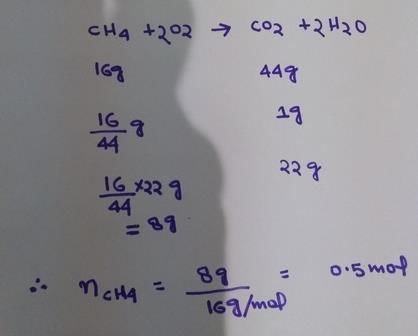Class 10 Exam > Class 10 Questions > How many moles of methane are required to pro...
Start Learning for Free
How many moles of methane are required to produce 22g CO2(g) after combustion?
Most Upvoted Answer
How many moles of methane are required to produce 22g CO2(g) after com...

Community Answer
How many moles of methane are required to produce 22g CO2(g) after com...
Problem Statement:
How many moles of methane are required to produce 22g CO2(g) after combustion?
Solution:
Step 1: Balanced chemical equation
We need to start by writing the balanced chemical equation for the combustion of methane (CH4):
CH4 + 2O2 -> CO2 + 2H2O
This equation shows that one molecule of methane reacts with two molecules of oxygen to produce one molecule of carbon dioxide and two molecules of water.
Step 2: Molar mass
To find the number of moles, we need to calculate the molar mass of CO2. Carbon has a molar mass of 12.01 g/mol, and oxygen has a molar mass of 16.00 g/mol. Since carbon dioxide (CO2) has one carbon atom and two oxygen atoms, its molar mass is:
Molar mass of CO2 = (12.01 g/mol) + 2(16.00 g/mol) = 44.01 g/mol
Step 3: Conversion
Now we can use the molar mass of CO2 to convert the given mass (22g) into moles.
Number of moles = Mass (g) / Molar mass (g/mol)
Number of moles = 22g / 44.01 g/mol
Number of moles = 0.499 moles
Step 4: Stoichiometry
According to the balanced chemical equation, one mole of methane reacts to produce one mole of carbon dioxide. Therefore, the number of moles of methane required would also be 0.499 moles.
Answer:
Therefore, 0.499 moles of methane are required to produce 22g of CO2(g) after combustion.
How many moles of methane are required to produce 22g CO2(g) after combustion?
Solution:
Step 1: Balanced chemical equation
We need to start by writing the balanced chemical equation for the combustion of methane (CH4):
CH4 + 2O2 -> CO2 + 2H2O
This equation shows that one molecule of methane reacts with two molecules of oxygen to produce one molecule of carbon dioxide and two molecules of water.
Step 2: Molar mass
To find the number of moles, we need to calculate the molar mass of CO2. Carbon has a molar mass of 12.01 g/mol, and oxygen has a molar mass of 16.00 g/mol. Since carbon dioxide (CO2) has one carbon atom and two oxygen atoms, its molar mass is:
Molar mass of CO2 = (12.01 g/mol) + 2(16.00 g/mol) = 44.01 g/mol
Step 3: Conversion
Now we can use the molar mass of CO2 to convert the given mass (22g) into moles.
Number of moles = Mass (g) / Molar mass (g/mol)
Number of moles = 22g / 44.01 g/mol
Number of moles = 0.499 moles
Step 4: Stoichiometry
According to the balanced chemical equation, one mole of methane reacts to produce one mole of carbon dioxide. Therefore, the number of moles of methane required would also be 0.499 moles.
Answer:
Therefore, 0.499 moles of methane are required to produce 22g of CO2(g) after combustion.

|
Explore Courses for Class 10 exam
|

|
Similar Class 10 Doubts
How many moles of methane are required to produce 22g CO2(g) after combustion?
Question Description
How many moles of methane are required to produce 22g CO2(g) after combustion? for Class 10 2025 is part of Class 10 preparation. The Question and answers have been prepared according to the Class 10 exam syllabus. Information about How many moles of methane are required to produce 22g CO2(g) after combustion? covers all topics & solutions for Class 10 2025 Exam. Find important definitions, questions, meanings, examples, exercises and tests below for How many moles of methane are required to produce 22g CO2(g) after combustion?.
How many moles of methane are required to produce 22g CO2(g) after combustion? for Class 10 2025 is part of Class 10 preparation. The Question and answers have been prepared according to the Class 10 exam syllabus. Information about How many moles of methane are required to produce 22g CO2(g) after combustion? covers all topics & solutions for Class 10 2025 Exam. Find important definitions, questions, meanings, examples, exercises and tests below for How many moles of methane are required to produce 22g CO2(g) after combustion?.
Solutions for How many moles of methane are required to produce 22g CO2(g) after combustion? in English & in Hindi are available as part of our courses for Class 10.
Download more important topics, notes, lectures and mock test series for Class 10 Exam by signing up for free.
Here you can find the meaning of How many moles of methane are required to produce 22g CO2(g) after combustion? defined & explained in the simplest way possible. Besides giving the explanation of
How many moles of methane are required to produce 22g CO2(g) after combustion?, a detailed solution for How many moles of methane are required to produce 22g CO2(g) after combustion? has been provided alongside types of How many moles of methane are required to produce 22g CO2(g) after combustion? theory, EduRev gives you an
ample number of questions to practice How many moles of methane are required to produce 22g CO2(g) after combustion? tests, examples and also practice Class 10 tests.

|
Explore Courses for Class 10 exam
|

|
Signup for Free!
Signup to see your scores go up within 7 days! Learn & Practice with 1000+ FREE Notes, Videos & Tests.
























